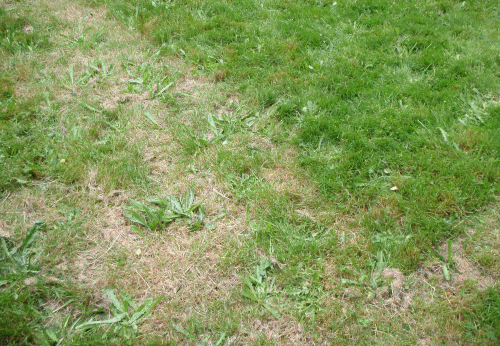The one thing about "Cheap and Lazy" that isn't instantly obvious is that is is also "slow and methodical" If you want something faster, you are going to move away from either cheap or lazy or both.
Paul (the author of the article) even mentions that he spent a few $100 on new top soil, which he had to spread over his lawn seed and water to fix it. That isn't cheap or lazy. (In his defense, care afterward was probably cheap and lazy)
"otherguy" its really going to matter where you feel you are on this spectrum, are you down by cheap and lazy or are you willing to put in some elbow grease and probably some money to speed things up?
I don't know where you live, but right now its mid summer and your lawn seems like its a bit "tired" Its probably browning out to save itself. Its trying to
save water and food for when it cools down and it can grow again. You may want to wait until fall or at least when it cools down.
As far as things to do, here is a quick list going for the most work and money to less
[li]Add topsoil (truck loads) and reseed the whole thing (in the fall, depending on where you are seed probably isn't going to grow well now.)[/li]
[li]Add topsoil (truck loads) and sod (I think you can do this in the summer this idea never appealed to me but that just me)[/li]
[li]Dig Worm Pits[/li]
[li]Top Dress with Compost[/li]
[li]Drench with Aerated Compost Tea(ACT)[/li]
[li]Fertilize everything[/li]
[li]Spot Fertilize [/li]
[li]Mow High and Water infrequently[/li]
A soil test isn't a bad idea as it will let you know whats going on and what kinds of changes you might need to make.
The list isn't exclusive, some of the folks here have done several of them at the same time such as topdress, ACT, worm pits, fertilize and of course mow high and water less.
I'm currently renting and am just mowing high and watering only as needed. My front yard looks pretty good. I have a neighbor that has a service take care of his lawn. I mow about 4" high, around once a week, I've watered a few times. His is cut at least weekly(very short too), its on an automatic irrigation so its watered daily and its look about the same, at best.
My backyard is a disaster. I just gave up, I just cut and water it as needed. It been interesting watching the weeds. the dead spots (just bare dirt) started getting things like clover and plantains. Then after about a while of just cutting/watering I noticed other plants competing for that space. In some areas, the grass is beginning to compete. I just don't want bare ground anything that is growing is going to get cut adding to the organic matter, nutrients in the soil. heh, if I did this for a few years, the backyard would come around. Having used this approach elsewhere, I know that the front yard would get get thicker, need less water and have fewer weeds.
Sorry for the mammoth post. One thing I will tell you I believe in this approach. I've seen it work in other places I've lived. It a good feeling to have a nice lawn that doesn't take that much work or money. Its especially nice when summer strikes and everyone's lawn is going dormant and your is still lush an green.



































































